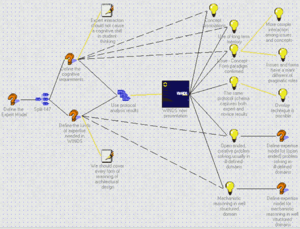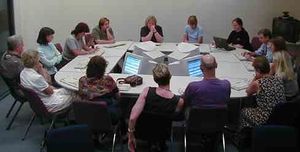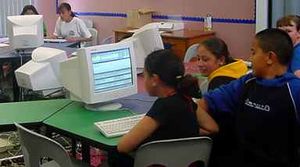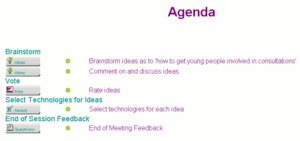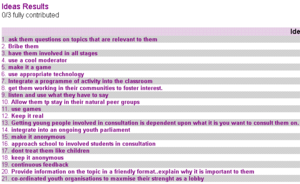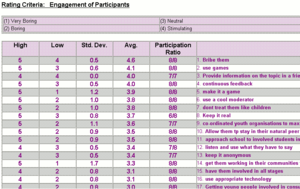Difference between revisions of "Mapping ideas"
(→IBIS) |
|||
| (18 intermediate revisions by 2 users not shown) | |||
| Line 1: | Line 1: | ||
| + | [[Image:dito_map.png|thumb]] | ||
| + | |||
Where consultation participants work together to explore the ramifications of a problem, and plan alternative solutions (e.g. in a citizens' jury). Technologies supporting this task may facilitate alternate stages of creative brainstorming and organising the ideas produced. Computer technologies can help in keeping track of these ideas, generating a map participants can see. With the map, they no longer need to keep on repeating the same point, again and again, like a politician being interviewed on the radio. | Where consultation participants work together to explore the ramifications of a problem, and plan alternative solutions (e.g. in a citizens' jury). Technologies supporting this task may facilitate alternate stages of creative brainstorming and organising the ideas produced. Computer technologies can help in keeping track of these ideas, generating a map participants can see. With the map, they no longer need to keep on repeating the same point, again and again, like a politician being interviewed on the radio. | ||
| − | + | ||
| − | + | Imagine a group tasked with exploring all the aspects of the problem, and coming up with several alternative solutions. How do you manage the meetings to use the time productively? Computer tools can help: | |
| − | + | *organise an agenda-driven meeting | |
| − | + | *allow lots of people to brainstorm ideas at the same time, without having to wait their turn to speak | |
| − | + | *allow pseudo-anonymity, so people are less afraid of coming up with creative, but risky ideas | |
| − | + | *help map out the issues discussed and the options identified. | |
| − | + | ||
| + | Technologies supporting this task may facilitate brainstorming, a technique groups use to generate ideas on a particular subject. Whereby, each person in the team is asked to think creatively and write down as many ideas as possible. The ideas are not discussed or reviewed until after the brainstorming session. From the results of the brainstorming, options are formulated which are then ranked or rated. | ||
| + | |||
| + | ==Zing electronic meeting software== | ||
| + | |||
| + | [[Image:Zing_conference.jpg|left|thumb|[http://www.anyzing.com/conferencerooms.html A Zing conference]]] | ||
| + | [[Image:Zing_classroom.jpg|right|thumb|[http://www.anyzing.com/schoolclassrooms.html Schoolchildren using Zing]]] | ||
| + | |||
| + | Using Zing numbers of keyboards can be plugged in to the same computer, so that people rapidly type in lists of examples and ideas in response to a series of questions. | ||
| + | |||
| + | We used [http://www.anyzing.com/ Zing] a number of times during our research project. The [http://www.cforc.org Centre for Competiveness] ran some sessions for us. One was during our Armagh Workshop. | ||
| + | *[http://wiki.e-consultation.org/tiki-download_file.php?fileId=33 Download the Armargh Zing session questions and ideas] | ||
| + | |||
| + | ==WebIQ== | ||
| + | |||
| + | [[Image:Webiq_agenda.png|left|thumb]] [[Image:Webiq_ideas.png|left|thumb]] [[Image:Webiq_rate.png|left|thumb]] [[Image:Webiq_xyplot.png|none|thumb]] | ||
| + | |||
| + | <br clear="all" />[http://www.webiq.net/ WebIQ] is a Group Support System that you can access through a web browser. It supports the usual range of meeting facilitation tools, such as brainstorming, classifying ideas, rating them on several dimensions, and so on. | ||
| + | |||
| + | We have used it to facilitate brainstorming sessions on how to evaluate e-consultation, in a number of [http://wiki.e-consultation.org/Theory theory-building workshops], and are now running our [http://collab.mgt.qub.ac.uk/ own WebIQ server] at the [http://www.qub.ac.uk/mgt/ Queen's University School of Management and Economics]. | ||
| + | |||
| + | ==Other maps== | ||
| + | *Issue-Based Information Systems (IBIS) map the structure of arguments in an issue-based hierarchy, thusly: | ||
| + | **Issues | ||
| + | ***Positions | ||
| + | ****Advantages and disadvantages | ||
| + | **This has been used in a number of research systems, such as those developed in Germany to facilitate town and regional planning discussions, such as [http://zeno8.gmd.de/zeno/ Dito] | ||
| + | *Geographical Information Systems (GIS) support location maps. | ||
| + | **The [http://www.communitywalk.com/ Community Walk] service lets you add comments to locations shown on Google maps. | ||
| + | ***Even semi-literate ex-offenders were able to use it to enter comments about Probation Service office locations. | ||
Latest revision as of 03:04, 8 December 2006
Where consultation participants work together to explore the ramifications of a problem, and plan alternative solutions (e.g. in a citizens' jury). Technologies supporting this task may facilitate alternate stages of creative brainstorming and organising the ideas produced. Computer technologies can help in keeping track of these ideas, generating a map participants can see. With the map, they no longer need to keep on repeating the same point, again and again, like a politician being interviewed on the radio.
Imagine a group tasked with exploring all the aspects of the problem, and coming up with several alternative solutions. How do you manage the meetings to use the time productively? Computer tools can help:
- organise an agenda-driven meeting
- allow lots of people to brainstorm ideas at the same time, without having to wait their turn to speak
- allow pseudo-anonymity, so people are less afraid of coming up with creative, but risky ideas
- help map out the issues discussed and the options identified.
Technologies supporting this task may facilitate brainstorming, a technique groups use to generate ideas on a particular subject. Whereby, each person in the team is asked to think creatively and write down as many ideas as possible. The ideas are not discussed or reviewed until after the brainstorming session. From the results of the brainstorming, options are formulated which are then ranked or rated.
Zing electronic meeting software
Using Zing numbers of keyboards can be plugged in to the same computer, so that people rapidly type in lists of examples and ideas in response to a series of questions.
We used Zing a number of times during our research project. The Centre for Competiveness ran some sessions for us. One was during our Armagh Workshop.
WebIQ
WebIQ is a Group Support System that you can access through a web browser. It supports the usual range of meeting facilitation tools, such as brainstorming, classifying ideas, rating them on several dimensions, and so on.
We have used it to facilitate brainstorming sessions on how to evaluate e-consultation, in a number of theory-building workshops, and are now running our own WebIQ server at the Queen's University School of Management and Economics.
Other maps
- Issue-Based Information Systems (IBIS) map the structure of arguments in an issue-based hierarchy, thusly:
- Issues
- Positions
- Advantages and disadvantages
- Positions
- This has been used in a number of research systems, such as those developed in Germany to facilitate town and regional planning discussions, such as Dito
- Issues
- Geographical Information Systems (GIS) support location maps.
- The Community Walk service lets you add comments to locations shown on Google maps.
- Even semi-literate ex-offenders were able to use it to enter comments about Probation Service office locations.
- The Community Walk service lets you add comments to locations shown on Google maps.
